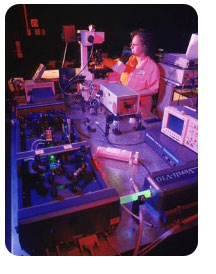Scientists, get ready for some disruption.
Last month I wrote about Quartzy, a nifty startup that’s looking to help scientists streamline their labs by making it easy to keep track of who has which reagents (which is actually a bigger problem than you’d think).
And today we see the launch of another Y Combinator-funded startup called Science Exchange that’s looking to help researchers in a different way: it wants to make it easier for them to conduct experiments on the expensive and sometimes rare equipment housed at universities across the country. And eventually, the company hopes to reinvent the way scientists outsource research in the hopes of making it much more efficient.
Before we get into how they’re going to do that, here’s some background on how science research is conducted.
Cofounder Elizabeth Iorns, who has a Ph.D in Cancer Biology and is on the faculty at the University of Miami School of Medicine, explains that major universities often have what’s called a Core Facility — a special lab that houses the most valuable equipment, which can exceed $1 million per machine. It would obviously be cost-prohibitive to put these in each scientists’ lab, and many of them are only needed occasionally anyway. So, instead, scientists submit their experiments to the Core Facility, where they’re carried out by resource scientists (scientists who exclusively perform these ‘outsourced’ experiments, and aren’t conducting their own research). The resource scientists then give the results back to the researcher who requested them.
Of course, not every core facility has every piece of machinery. And Iorns says that when a researcher wants to use equipment that’s housed elsewhere, the logistics involved can be painful. There’s no central database tracking which universities have which equipment, there’s no standardization around payments systems, and even the price each core facility charges for an experiment can vary widely (this is in part, she explains, because the facilities that are used infrequently need to charge more to recoup their costs).
Science Exchange hopes to be the solution to this. The company is working to build out a central database that lets researchers look up where they can outsource an experiment, and how much it will cost them. It also processes the transactions, so researchers and universities don’t have to worry about making sure their payment systems are all integrated with each other (Science Exchange makes it money by taking a commission on each transaction). Average experiment prices are around $5,000 — and despite the commission universities oftentimes save money, because they can find core facilities with lower fees.
And Iorns says that the universities with underutilized core facilities, which typically charge higher fees, can close them without having to worry too much about their faculty leaving, since they’ll be able to more easily outsource their experiments.
In the longer term, Iorns says that the startup wants to help streamline an even broader range of experiments that don’t necessarily involve core facilities. What if, for example, a researcher could dedicate one day per week to conducting experiments submitted by other researchers? They could offer to perform experiments specifically related to their specialties, which could generate even more accurate results than if these researchers had conducted the experiments at their own labs. Of course, this could lead to issues around establishing who is actually reliable, but Iorns says this could be addressed using a reputation system.
But that’s still a ways off. For now, they’re sticking with the core facilities. So far, they say the results have been promising — and I think it sounds like a great idea.
The startup’s team consists of Iorns, Ryan Abbott (formerly cofounded Loudpixel), and Dan Knox (formerly a VP at DailyMe).
